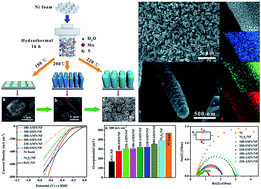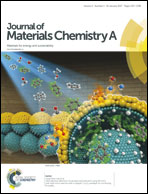Controlled synthesis of Mo-doped Ni3S2 nano-rods: an efficient and stable electro-catalyst for water splitting†
Abstract
Fabrication of stable, efficient, and inexpensive bifunctional electro-catalysts for water splitting has become increasingly attractive. Herein, for the first time, the direct growth of Mo-doped Ni3S2 on Ni foams using sodium molybdate as the Mo source at different temperatures is demonstrated. Effects of temperature on the morphology and water splitting performance of Mo-doped Ni3S2 were discussed in detail. It is found that the atomic stoichiometric ratios of Mo and Ni can be controlled by the adjusting of reaction temperature, while the obtained electro-catalysts demonstrate various morphologies, capacitances and chemisorption free energies of hydrogen, which lead to different current densities and hydrogen evolution efficiencies. The electro-catalyst synthesized at 200 °C (200-SMN/NF) demonstrates the best regular morphology and electrochemical properties. When employed in oxygen evolution reactions, 200-SMN/NF demonstrates a low over-potential of 180 mV at 100 mA cm−2. Adapting it as a bifunctional electro-catalyst, a current density of 10 mA cm−2 at a very low cell voltage of 1.53 V and cycling lifespan of more than 15 h was delivered. Further results indicated elevated hydrogen evolution reaction activity, consisting of a moderate 278 mV over-potential at a 100 mA cm−2 hydrogen production current density, a small 72.9 mV dec−1 Tafel slope, and a superior current density compared to that of precious catalyst Pt/C (40%) after −0.53 V. These results underscore the fact that 200-SMN/NF is a high-performance, precious-metal-free electro-catalyst, and provide the foundation for exciting opportunities in water splitting applications.

- This article is part of the themed collection: JMC A Editor’s choice collection: Recent advances in solar fuels and photocatalysis research

 Please wait while we load your content...
Please wait while we load your content...